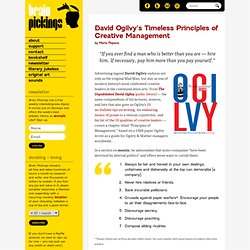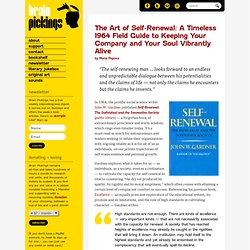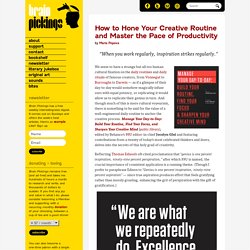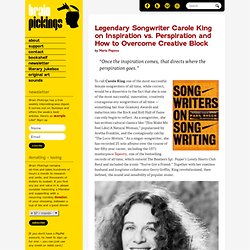

Scott Belsky on How to Avoid Idea Plateaus. How to Get Out of Your Own Way and Unblock the “Spiritual Electricity” of Creative Flow. By Maria Popova “No matter what your age or your life path … it is not too late or too egotistical or too selfish or too silly to work on your creativity.”

“Art is not a thing — it is a way,” Elbert Hubbard wrote in 1908. But the question of what that way is, where exactly it leads, and how to best follow it is something artists have been grappling with since the dawn of recorded time and psychologists have spent decades trying to decode, outlining the stages of creativity, its essential conditions, and the best technique for producing ideas. In 1978, a few months after she stopped drinking, artist, poet, playwright, novelist, filmmaker, composer, and journalist Julia Cameron began teaching artists — by the broadest possible definition — how to overcome creative block and get back on their feet after a “creative injury.”
Art by Sydney Pink from 'Overcoming Creative Block.' Writing in the introduction to the 10th anniversary edition, Cameron adds to the most beautiful definitions of art: How to Break Through Your Creative Block: Strategies from 90 of Today’s Most Exciting Creators. A 5-Step Technique for Producing Ideas circa 1939. Use Elon Musk's "First Principles" Method for Better Brainstorming. 10 Rules for Creative Projects from Legendary Painter Richard Diebenkorn.
By Maria Popova “Do search. But in order to find other than what it searched for.” On a recent visit to the Richard Diebenkorn: The Berkeley Years, 1953-1966 exhibition at San Francisco’s De Young fine arts museum , I was taken with a small, simple sheet of paper handed to visitors, printed on which were the artists’ ten rules for beginning a painting — a sort of manifesto that applies in various degrees and various dimensions to just about every creative or intellectual endeavor, making a fine addition to these favorite manifestos for the creative life . Friend-of- Brain Pickings and frequent contributor Debbie Millman , who knows a thing or two about hand-lettered wisdom and typographic poetics , has kindly rendered Diebenkorn’s script here in her signature script — please enjoy: Complement this with Salvador Dalí’s creative credo .
Donating = Loving Bringing you (ad-free) Brain Pickings takes hundreds of hours each month. Brain Pickings has a free weekly newsletter. Share on Tumblr. David Ogilvy’s Timeless Principles of Creative Management. By Maria Popova “If you ever find a man who is better than you are — hire him.

If necessary, pay him more than you pay yourself.” Advertising legend David Ogilvy endures not only as the original Mad Man, but also as one of modern history’s most celebrated creative leaders in the communication arts. The Art of Self-Renewal: A Timeless 1964 Field Guide to Keeping Your Company and Your Soul Vibrantly Alive. By Maria Popova “The self-renewing man … looks forward to an endless and unpredictable dialogue between his potentialities and the claims of life — not only the claims he encounters but the claims he invents.”

In 1964, the prolific social science writer John W. Gardner published Self-Renewal: The Individual and the Innovative Society (public library) — a forgotten book of extraordinary prescience and warm wisdom, which rings even timelier today. Anaïs Nin on Writing, the Future of the Novel, and How Keeping a Diary Enhances Creativity: Wisdom from a Rare 1947 Chapbook. By Maria Popova “It is in the moments of emotional crisis that human beings reveal themselves most accurately.”

In December of 1946, Anaïs Nin was invited to give a lecture on writing at Dartmouth, which received an overwhelming response. The following summer, after receiving countless requests, Nin adapted the talk in chapbook titled On Writing, which she printed at her own Gremor Press — the small publishing house Nin founded in 1942 out of disillusionment with mainstream publishing, which led her to teach herself letterpress and self-publish a handful of elegant manually typeset books with gorgeous engravings by her husband.
The Power of Process: What Young Mozart Teaches Us About the Secret of Cultivating Genius. By Maria Popova On the “powerful blend of instruction, encouragement, and constant practice.” “The trick to creativity … is to identify your own peculiar talent and then to settle down to work with it for a good long time,” observed Denise Shekerjian in reflecting on her insightful interviews with MacArthur “genius” grantees. “Success is the product of the severest kind of mental and physical application,” attested Thomas Edison. “It is the man who carefully advances step by step, with his mind becoming wider and wider … who is bound to succeed in the greatest degree,” Alexander Graham Bell proclaimed. And yet our culture continues to perpetuate the notion that genius is a “God”-given blessing.
Anonymous portrait of the child Mozart, possibly by Pietro Antonio Lorenzoni; painted in 1763 on commission from Leopold Mozart (public domain) You Don’t Have to Start Big, You Just Have to Start. The Science of Productivity, Animated. 18 Things Highly Creative People Do Differently. This list has been expanded into the new book, “Wired to Create: Unravelling the Mysteries of the Creative Mind,” by Carolyn Gregoire and Scott Barry Kaufman. Creativity works in mysterious and often paradoxical ways. Creative thinking is a stable, defining characteristic in some personalities, but it may also change based on situation and context. Inspiration and ideas often arise seemingly out of nowhere and then fail to show up when we most need them, and creative thinking requires complex cognition yet is completely distinct from the thinking process.
Neuroscience paints a complicated picture of creativity. As scientists now understand it, creativity is far more complex than the right-left brain distinction would have us think (the theory being that left brain = rational and analytical, right brain = creative and emotional). How to Master Your Creative Routine and the Pace of Productivity. By Maria Popova “When you work regularly, inspiration strikes regularly.”

The Long Game: Brilliant Visual Essays on the Only Secret to Creative Success, from Leonardo da Vinci to Marie Curie. By Maria Popova Why showing up day in and day out without fail is the surest way to achieve lasting success.

Legendary Songwriter Carole King on Inspiration vs. Perspiration and How to Overcome Creative Block. By Maria Popova “Once the inspiration comes, that directs where the perspiration goes.”

To call Carole King one of the most successful female songwriters of all time, while correct, would be a disservice to the fact that she is one of the most successful, innovative, creatively courageous any songwriters of all time — something her four Grammy Awards and induction into the Rock and Roll Hall of Fame can only begin to reflect. As a songwriter, she has written cultural classics like “(You Make Me Feel Like) A Natural Woman,” popularized by Aretha Franklin, and the contagiously catchy “The Loco-Motion.” As a singer-songwriter, she has recorded 25 solo albums over the course of her fifty-year career, including the 1971 masterpiece Tapestry, one of the bestselling records of all time, which outsold The Beatles’s Sgt. Pepper’s Lonely Hearts Club Band and included the iconic “You’ve Got a Friend.” That song was as close to pure inspiration as I’ve ever experienced.
Donating = Loving. The Psychology of Writing and the Cognitive Science of the Perfect Daily Routine. The Three Questions You Should Ask to Think More Critically. John Cleese on the 5 Factors to Make Your Life More Creative. By Maria Popova “Creativity is not a talent.

It is a way of operating.” Much has been said about how creativity works, its secrets, its origins, and what we can do to optimize ourselves for it. In this excerpt from his fantastic 1991 lecture, John Cleese offers a recipe for creativity, delivered with his signature blend of cultural insight and comedic genius. Specifically, Cleese outlines “the 5 factors that you can arrange to make your lives more creative”: Kickstart your creativity. Joi Ito: Want to innovate? Become a "now-ist" Elizabeth Gilbert: Your elusive creative genius.